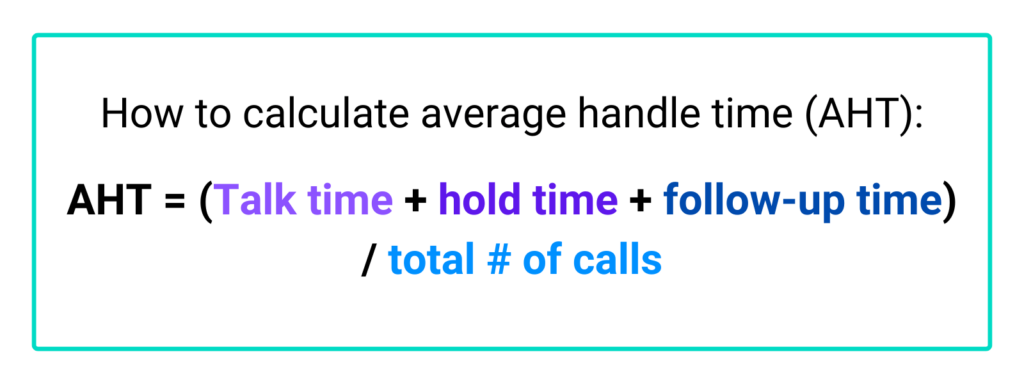Time is your customers’ most precious commodity. It’s the one thing they can never get back. When your customers are experiencing a problem, it’s critical to resolve the issue as quickly as possible.
But how can you ensure that your tech support team delivers timely service? In short, by tracking average handle time. Average handle time is vital to understanding your customer service teams’ performance.
Below, we explain what average handle time is, how to calculate it and steps your company can take to improve it.
What is average handle time?
Average handle time is an overall measure of the length of the average interaction between your customer service agents and a customer. It’s one of the many key contact center metrics your company should track to understand overall performance.
How to calculate average handle time
To calculate your average handle time, you need four key metrics: total talk time, total hold time, follow-up time and the number of calls in a given timeframe. Once you have those, you’ll need to add the talk, hold and follow-up time together and divide that by the total number of calls.

For example, Let’s say your total talk time is 1,000 minutes, your total hold time is 600 minutes, your follow-up time is 400 minutes and you have 500 total calls. You’d add 1,000 plus 600 plus 400 to get 2,000. Then, you’d divide by 500. This would give you an average handle time of four minutes. That means that it takes your agents an average of four minutes to resolve a customer support issue.
What is a good average handle time?
Like any other key performance indicator (KPI), the ideal average handle time varies by industry. In general, the benchmark for telecommunications companies' average handle time is just under nine minutes. For broadband, it’s a little over four and a half minutes.
Why does average handle time matter?
Reducing average handle time is vital for the success of your contact center. The faster you can answer customer inquiries, the happier they’ll be. Reducing average handle time can help you improve your net promoter score (NPS), reduce customer churn and lower business expenses.
Five ways you can improve average handle time
Reducing average handle time is vital for increasing customer retention and creating a better customer experience. Below are a few steps you can take to improve average handle time at your contact center.
1. Invest in your contact center agent onboarding program
A strong contact center agent onboarding program makes a significant impact on your average handle time.
When agents have the proper knowledge to confidently answer customers' tech support inquiries, they can resolve issues more quickly without transferring customers to another agent or calling them back.
This, in turn, can increase your business's first-call resolution rates.
Your onboarding program should set clear expectations and goals to set agents up for success. Use a S.M.A.R.T. goals framework, meaning all goals should be specific, measurable, achievable, relevant and time-bound.
Additionally, provide clear, constructive feedback to help new contact center agents understand what they're doing well and where they can improve. Consider creating a mentorship program to pair new agents with more experienced ones.
2. Harness the power of chatbots
There are many benefits of using chatbots in customer service, especially when it comes to reducing average handle time. With chatbots, customers skip lengthy hold times and get access to instant customer support.
Chatbots are great for handle customers’ frequently asked questions. As a result, call volume is reduced at your contact center, freeing agents up to answer more complex inquiries.
Chatbots can also be a powerful tool for tailoring your customer service strategy to Gen Z. Gen Z tends to dislike phone calls, meaning companies that want to tap into their $360 billion in spending power need to implement alternatives to calling a contact center.
Chatbots can help you create the customer experience zoomers crave. Almost a third of Gen Zers say chatbots are their preferred channel for receiving tech support. Zoomers are willing to hang up after holding for just 45 seconds, so speed is paramount to retaining this segment of your customer base.
3. Keep your phone greeting brief
Your automatic phone greeting is the first thing customers hear when they call your contact center. When creating the prompt for this greeting, brevity is your friend. According to the National Customer Rage survey, listening to long prompts before speaking with a human representative is the top frustration for customers.
Think about this from the customer’s perspective. If they’re calling your contact center for support, it’s not because things are going great. They’re already frustrated because their smart device won’t connect to their home network, they’re struggling with the self-serve onboarding process or something else isn’t working as expected.
When customers call your contact center, they feel frustrated about something. Make it easy for them to get the help they need to get back to their streaming, work or whatever they need to do as quickly as possible.
4. Consider leveraging live video support
To help agents resolve customer service issues faster and lower your average handle time, equip them with the right tools for the job. Live video support can be a great resource for agents to provide accurate, reliable tech support.
Before live video support, a customer calling your contact center would have to describe to the agent what's happening and what they're seeing on their screen. This can create a lot of unnecessary back and forth, as customers may not know the exact terminology to describe what's happening, and agents aren't familiar with the customer's home or office setup.
Consequently, agents may ask the customer to repeat themselves multiple times, or it could take numerous follow-ups to resolve an issue.
Live video support helps improve communication between customers and agents because the agent can see what the customer sees. For example, instead of asking customers to describe where they've set up their internet router, the agent can see it and provide customers with next steps to resolve their issue.
As a result, agents can provide more accurate, personalized customer service that helps customers get back to using their devices or other services faster. This can reduce the number of follow-ups, the length of phone calls and improve the customer service experience.
5. Implement interactive self-service tutorials
Did you know that 88% of customers expect your business to provide self-service options? Interactive tutorials can be a powerful tool to reduce average handle time and provide the customer self-service experience your customers crave.
43% of customers prefer interactive content. Interactive content can help customers better retain information than text-based self-service tools. As a result, your company can reduce the truck rolls and customer churn rates.
Additionally, digital adoption increases as customers successfully use your interactive tutorials. In turn, contact center wait times and call volume are reduced, which all help to reduce average handle time (without sacrificing quality tech support).
Reduce your company’s average handle time
Average handle time is a key metric for understanding your contact center’s performance. Ideally, the smaller the number, the better, but don’t opt for poor customer service in the pursuit of speediness. By following the tips here, you can focus on reducing average handle time without sacrificing service quality.

Is your company looking to reduce your average handle time? Tools like remote video support can help your agents reduce average handle time, provide faster service resolution and reduce customer churn. Learn more about the future of customer service today!



